Welcoming a baby lovebird into your life can be an incredibly rewarding experience. These small, colorful parrots are known for their playful and affectionate nature, making them delightful companions for bird enthusiasts.
However, caring for these tiny bundles of feathers requires careful attention and dedication. In this comprehensive guide, we will explore the essential aspects of how to take care of baby lovebirds.
From creating a safe and nurturing environment to understanding their nutritional needs and socialization, we’ll cover everything you need to know to raise happy and healthy baby lovebirds.
Whether you’re a first-time lovebird parent or looking to expand your avian family, this guide will provide you with the knowledge and tips necessary to ensure these charming birds thrive in your care. Stay focused.
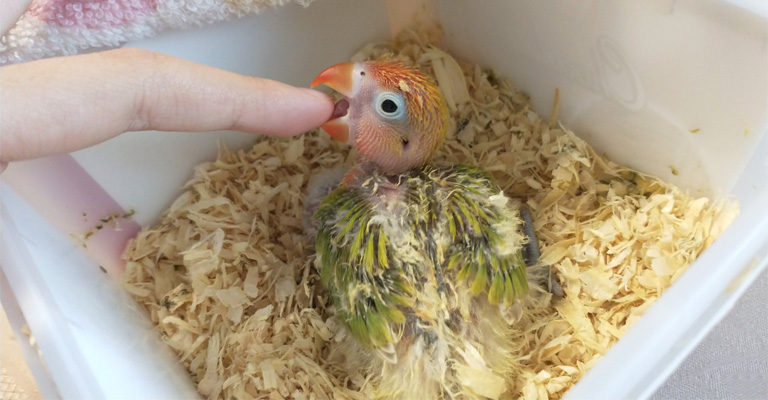
Preparation for Welcoming A Baby Lovebird
Preparing to welcome a baby lovebird into your home involves several key steps. First, ensure you have a suitable cage with appropriate bar spacing to prevent escapes. Stock up on essential supplies, including fresh bird food, a water dispenser, and bird-safe toys for mental stimulation.
Create a safe and comfortable environment by bird-proofing your home. Remove hazards like toxic plants and chemicals, and secure windows and doors to prevent accidental escapes. Invest in a cozy nesting box or platform for the parents to raise their chicks.
Plan a balanced diet of seeds, pellets, fruits, and vegetables to meet their nutritional needs. Consult an avian veterinarian for guidance on their specific dietary requirements.
Lastly, allocate time for socialization and bonding with your baby lovebird. Gentle interaction and patience will foster a trusting relationship. With proper preparation, you’ll be well on your way to providing a loving and secure home for your new feathered family member.
How to Take Care of Baby Lovebirds?
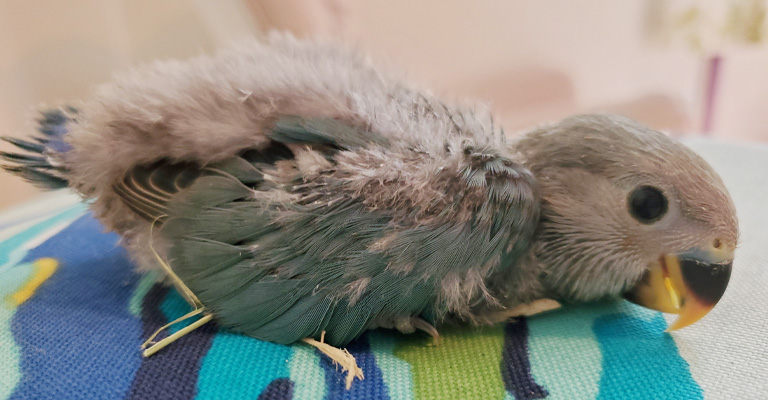
Taking care of baby lovebirds requires attention to their unique needs, especially during their early stages of development. Here are some essential tips for caring for baby lovebirds:
Nesting Area
Ensure the nesting area is clean, secure, and free from disturbances. Provide a suitable nesting box or platform for the parents to care for their chicks.
Diet
Baby lovebirds initially rely on their parents for food. Ensure the parents are receiving a balanced diet, as this directly impacts the nutrition the chicks receive. Consult an avian veterinarian for dietary advice.
Temperature
Maintain a stable temperature in the nesting area, usually around 85-90°F (29-32°C) during the first few weeks. Use a heat lamp or heating pad if needed, but ensure there are cooler areas in the cage if the chicks become too warm.
Hydration
Ensure access to fresh water for the parents, as they need it to feed the chicks. Baby lovebirds initially get their hydration from the food the parents regurgitate.
Observation
Keep a watchful eye on the chicks’ development. Ensure they are growing at a steady rate, and their crops (a pouch-like structure where food is temporarily stored) are full after feedings.
Socialization
Handle the baby lovebirds gently and regularly to help them become accustomed to human interaction. This will make them more social and less stressed as they grow.
Weaning
Around 6-8 weeks of age, baby lovebirds will start weaning. Offer them softened pellets, fresh fruits, and vegetables. Gradually reduce their dependency on the parents’ regurgitated food.
Healthcare
Regularly consult with an avian veterinarian for health check-ups and vaccinations. Address any health concerns promptly.
Social Interaction
Spend time with your baby lovebirds to build trust and strengthen the bond. Play with them, talk to them, and provide toys for mental stimulation.
Transition to a New Home
If you plan to rehome the baby lovebirds, ensure that their new environment is safe, and the new owners are knowledgeable about their care.
Remember that raising baby lovebirds can be a delicate and challenging process, and it’s essential to educate yourself and seek professional advice when needed.
How to Set Up the Home for a Baby Lovebird?
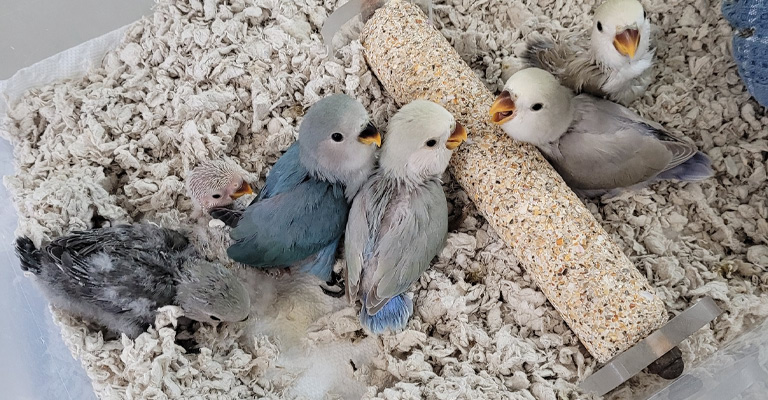
Setting up your home for a baby lovebird requires careful preparation to provide a safe and comfortable environment. Here’s how to do it:
Cage Selection
Choose an appropriate cage that allows room for growth and exercise. Make sure the bar spacing is narrow enough to prevent escapes (about 1/2 inch or 1.27 cm for lovebirds). A larger cage is better for the bird’s well-being.
Cage Placement
Place the cage in a well-lit area, away from drafts, direct sunlight, and extreme temperature fluctuations. Avoid areas with high humidity or near the kitchen, as cooking fumes can be harmful.
Cage Accessories
Inside the cage, include perches of varying thickness and texture to promote foot health. Provide a shallow dish for food and a separate one for fresh water. Hang some toys for mental stimulation and exercise.
Bedding
Line the cage bottom with safe, clean bedding material. Many bird owners use newspaper or specially designed cage liners. Change the bedding regularly to maintain cleanliness.
Nesting Area
If you plan to breed lovebirds, provide a nesting box with an entrance hole appropriate for lovebirds. Ensure the nesting area is private and quiet to minimize disturbances.
Safety Measures
Bird-proof your home by removing potential hazards. Keep toxic plants, chemicals, and small objects that the bird might ingest out of reach. Cover electrical cords to prevent chewing.
Temperature Control
Maintain a comfortable temperature between 70-80°F (21-27°C) in the room where the bird’s cage is located. Ensure that the cage is not exposed to drafts or direct airflow from air conditioning or heating vents.
Socialization Area
Set up a play area outside the cage where your baby lovebird can interact and exercise under supervision. Provide perches, toys, and a safe space for flying.
Supplies
Stock up on essential supplies, including quality bird food, fresh fruits, and vegetables. Have a supply of clean water and food dishes, as well as a bird bath for hygiene.
Healthcare Kit
Have a basic healthcare kit on hand, including nail clippers, a grooming perch, and an avian first-aid kit in case of emergencies.
Training Materials
Invest in educational materials or seek guidance from avian experts to understand lovebird behavior and training techniques.
Socialization
Spend quality time with your baby lovebird daily to build trust and establish a bond. Gradually introduce them to the cage and play area outside.
Remember that lovebirds are social birds that thrive on interaction and mental stimulation. Providing a secure, comfortable, and stimulating environment is key to ensuring your baby lovebird’s well-being and happiness.
Feeding Baby Lovebirds
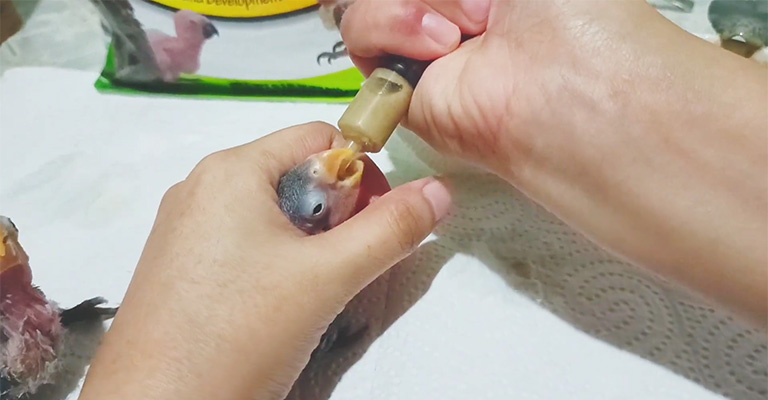
Feeding baby lovebirds requires careful attention to their nutritional needs. In the early stages of their life, baby lovebirds are entirely dependent on their parents for nourishment. If you’re hand-raising them or need to supplement their diet, here’s how to feed baby lovebirds:
Formula Preparation
- Purchase a high-quality hand-feeding formula specifically designed for baby parrots or lovebirds.
- Follow the instructions on the formula packaging for proper mixing. Typically, you’ll need to mix the formula with warm water until it reaches a smooth, pudding-like consistency.
Feeding Tools
Use a clean and sterile syringe or a specialized hand-feeding spoon to feed the baby lovebirds. Ensure that the feeding equipment is sanitized before each use.
Temperature
The formula should be served at a temperature of around 105-110°F (40-43°C). Test it on your wrist to ensure it’s not too hot.
Feeding Frequency
Baby lovebirds require frequent feedings, especially during their first few weeks. Feed them every 2-3 hours during the day, gradually extending the time between feedings as they grow.
Feeding Technique
- Gently hold the baby lovebird in your hand or on a soft towel. Position the syringe or spoon at the side of its beak, not directly into the throat, and allow the chick to suck the formula at its own pace.
- Be patient and gentle, ensuring not to force-feed or overfeed, which can lead to aspiration or crop issues.
Crop Monitoring
After each feeding, observe the chick’s crop, a pouch-like structure in the throat where food is temporarily stored. It should be full but not overly stretched. If it feels overly full or remains empty, consult a veterinarian.
Gradual Weaning
- As the baby lovebirds grow, introduce them to soft, mashed fruits and vegetables and softened pellets. This is the beginning of the weaning process.
- Continue to provide hand-feeding formula as needed until they are fully weaned, which typically occurs around 6-8 weeks of age.
Cleanliness
Maintain strict hygiene throughout the feeding process. Clean the feeding equipment, syringes, and the chicks’ beaks after each feeding to prevent contamination and infection.
Professional Guidance
If you are unsure about hand-feeding or encounter any issues, seek advice and guidance from an experienced avian veterinarian or a breeder.
Hand-raising baby lovebirds can be a delicate and time-consuming task, and it’s essential to ensure that you are fully prepared and knowledgeable about their specific needs before attempting it.
Tips on Health and Veterinary Care for a Baby Lovebird
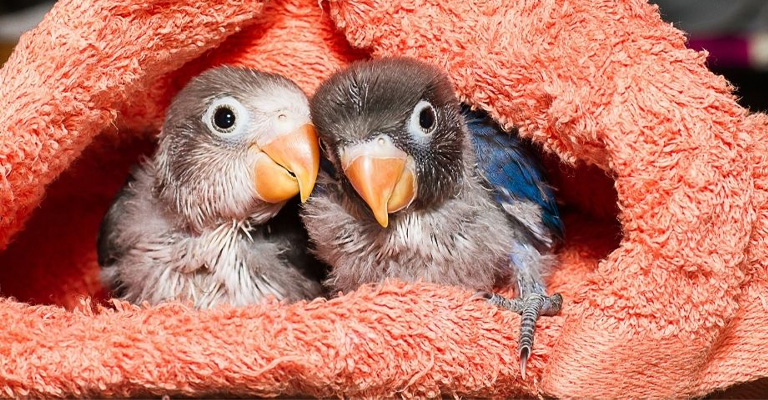
Ensuring the health and veterinary care of your baby lovebird is crucial for its well-being and longevity. Here are some tips on health and veterinary care for a baby lovebird:
Find an Avian Veterinarian
Locate a qualified avian veterinarian experienced in treating birds, especially lovebirds. Regular check-ups are essential to catch and address health issues early.
First Vet Visit
Schedule an initial veterinary examination shortly after acquiring your baby lovebird. This visit will establish a baseline for its health and provide important information on care and diet.
Vaccinations
Discuss with your veterinarian if your lovebird needs any specific vaccinations based on its age and health status. Follow their recommendations for vaccinations and boosters.
Quarantine
Isolate any new lovebirds from your existing ones for a quarantine period to prevent the potential spread of diseases. Consult your veterinarian on the recommended quarantine duration.
Dietary Consultation
Seek advice from your veterinarian regarding the appropriate diet for your baby lovebird. They can recommend the right balance of pellets, seeds, fruits, vegetables, and supplements.
Weight Monitoring
Regularly weigh your lovebird to track its health. Sudden weight loss or gain can be an early sign of illness.
Behavioral Changes
Pay attention to any changes in your lovebird’s behavior, such as increased lethargy, decreased appetite, or changes in vocalization. These could be signs of illness.
Proper Housing
Ensure your lovebird’s cage and environment are clean and safe. Clean the cage regularly, provide fresh water daily, and offer a variety of toys and mental stimulation.
Grooming
Consult your veterinarian on how to maintain your lovebird’s nails and beak. Some birds may require occasional trimming to prevent overgrowth.
Wing Clipping
Discuss wing clipping with your veterinarian. Depending on your lovebird’s behavior and the environment, they may recommend wing clipping to prevent dangerous flying accidents.
Parasite Prevention
Learn about common parasites that can affect lovebirds, such as mites and worms. Consult your veterinarian on prevention and treatment options.
Emergency Plan
Have an emergency plan in place in case your lovebird becomes seriously ill or injured. Know the location and contact information for an avian emergency clinic.
Socialization
Keep your lovebird mentally and emotionally stimulated with social interaction and enrichment activities. Boredom can lead to health and behavioral issues.
Educate Yourself
Continuously educate yourself about lovebird care and health. Stay up to date with reputable avian care resources and literature.
Remember that lovebirds are social birds, and their well-being is closely tied to their social interactions and mental stimulation.
Regular veterinary care, a balanced diet, and a safe, clean environment are essential components of ensuring your baby lovebird remains healthy and happy throughout its life.
Tips on Training the Baby Bird
Training a baby bird, such as a lovebird, requires patience, consistency, and positive reinforcement. Here are some tips to help you train your baby bird effectively:
Start Early
Begin training as early as possible. Young birds are more receptive to learning and forming bonds.
Positive Reinforcement
Use positive reinforcement techniques, such as praise, treats, or a favorite toy, to reward desired behaviors. Lovebirds respond well to rewards like millet sprays, fresh fruits, or verbal praise.
Basic Obedience Commands
Start with basic commands like “step up,” “step down,” and “stay.” Be consistent with the chosen command words and use them gently and calmly.
Taming and Socialization
Spend quality time with your baby bird to build trust and socialize it. Handle the bird gently and regularly to get it used to your presence.
Target Training
Use a target stick or your finger as a target. Train your bird to touch the target with its beak, then reward it. This helps with teaching other tricks and commands.
Clicker Training
Clicker training can be effective for lovebirds. Use a clicker to mark the desired behavior, followed by a reward. The clicker sound serves as a clear signal for the bird.
Short Sessions
Keep training sessions short and engaging. Birds have short attention spans, so 10-15 minute sessions are generally more effective than longer ones.
Consistency
Be consistent with your training schedule and methods. Birds thrive on routine and predictability.
Patience
Be patient and understanding. Birds may not respond immediately, and progress may be slow. Avoid scolding or punishing your bird, as it can be counterproductive.
Respect Boundaries
Respect your bird’s boundaries. If it shows signs of stress or discomfort, back off and try again later. Pushing too hard can lead to fear and aggression.
Environmental Enrichment
Provide a stimulating environment with toys and puzzles to keep your bird mentally active. A mentally stimulated bird is often more cooperative in training.
Social Learning
Birds are observant and can learn from watching other birds or even humans. Allow your bird to watch other trained birds if possible.
Desensitization
Gradually introduce your bird to new experiences, objects, and people. This helps reduce fear and anxiety.
Routine Handling
Regularly handle and interact with your bird, even outside of formal training sessions. This helps maintain the bond and reinforces positive behavior.
Consult a Professional
If you encounter challenges or behavioral issues, consider seeking the help of a professional bird trainer or behaviorist.
Remember that each bird is unique, and training progress may vary. Building trust and a positive relationship with your lovebird should be the foundation of all training efforts.
FAQs
Baby lovebirds typically start eating on their own, a process known as weaning, around 6-8 weeks of age. Introduce softened pellets, fresh fruits, and vegetables gradually while reducing the hand-feeding formula.
Maintain a warm environment with a stable temperature of 85-90°F (29-32°C) during the first few weeks. You can use a heat lamp or heating pad to provide warmth, ensuring there are cooler areas in the cage if needed.
Lovebirds do not typically require vaccinations like dogs or cats. However, consult an avian veterinarian for specific health advice and potential vaccinations based on the bird’s age, health, and potential exposure to diseases.
Clean the cage regularly. Remove droppings and leftover food daily, and change the bedding frequently. A thorough cage cleaning should be done at least once a week to maintain a clean and hygienic environment.
If your baby lovebird is not gaining weight or appears unhealthy, consult an avian veterinarian immediately. Weight loss or stunted growth can indicate health issues that require professional attention. Early intervention is crucial for their well-being.
Wrapping Up
As you embark on this exciting journey of caring for baby lovebirds, remember that patience, love, and vigilance are your most valuable tools.
Providing a warm and secure home, nourishing their bodies with a balanced diet, and nurturing their hearts with affection will create a harmonious bond between you and your feathered friends.
By following the tips and guidelines outlined in this guide, you’re well-equipped to give your baby lovebirds the best start in life, fostering a strong and enduring relationship that will bring joy to your life for years to come. Happy bird parenting!